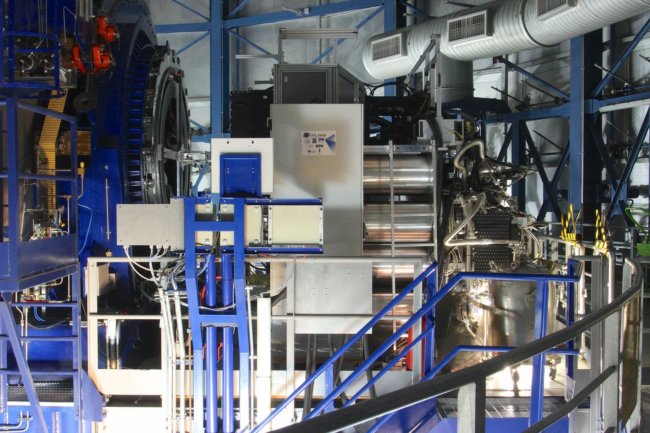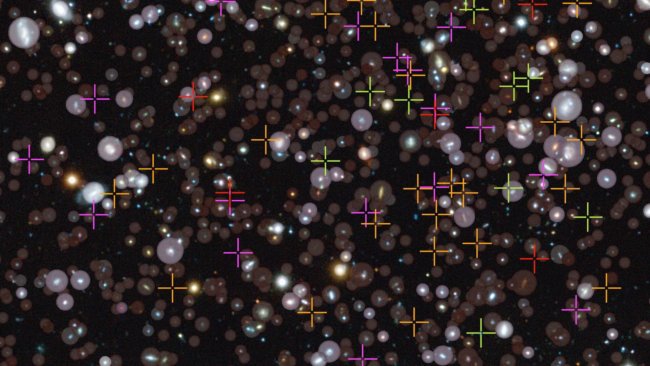
Through the use of a new scientific instrument MUSE (Multi Unit Spectroscopic Explorer) is installed on the Very large telescope (VLT) the European southern Observatory in Chile, astronomers were able to detect 72 of the new galaxy. The discovery was part of a deep spectroscopic study of the cosmos in the entire history of such observations.
All the detected galaxies are located in a relatively small area of sky called the Hubble Ultra Deep Field (HUDF). This area of the cosmos studied by astronomers for more than 10 years, however, to detect a new galaxy was only after the VLT has been installed the new MUSE instrument, which in their circles is called the cosmic time machine, as it allows a detailed study of very distant galaxies. Previously to detect these galaxies failed because they belong to the so-called sources of Lyman-alpha particles, which means are visible only in one certain color spectrum, writes portal Futurism.

Unlike telescopes, which are used to explore the region of Hubble Ultra Deep Field, the MUSE instrument uses the method of spectrometry in order to break light up into its constituent component colors.
“With this equipment we can figure out the distance to the object, color and other properties of all galaxies, which we see, including even those that are invisible to the telescope “Hubble”,” — said in a press release, head of the research program MUSE Roland bacon of the Lyon astrophysics research center.
In addition to the opening of 72 new galaxies, the researchers conducted with the help of the MUSE instrument is incredibly detailed spectroscopic study of a total of 1600 different galaxies. In turn, when using ground-based telescopes with the same aims, scientists were able to collect the same exact data only for 1/10 of that number of galaxies.
The amount of data collected by the tool MUSE long enough to write 10 scientific papers, all of them will be published in the next issue of the scientific journal Astronomy & Astrophysics. The list of topics ranged from questions about how the stars formed in the early Universe, and to how matter fills and, on the contrary, leaves the galaxy.
But perhaps the most interesting thing here is so, what contribution all these collected data can contribute to the solution of our question in the search for extraterrestrial life.
Astronomers estimate that in our galaxy the milky Way contains up to 400 billion stars. If we assume that eight planets in our Solar system is the average number of planets in other systems, in this case, it is only in our galaxy, the total number of planets could be from 800 billion to 3.2 trillion.
If each of the 72 newly discovered galaxies contains at least the minimum expected number of stars (scientists think it’s about 100 billion), then our list of potential targets for the search for extraterrestrial life to include a minimum of 57.6 trillion of new planets.
Our search technology is constantly improving, and therefore increase the chances of discovery of life beyond Earth. Several future developments in technology telescopes will additionally contribute to more efficient learning and searching for new galaxies with MUSE, who will speak in a peculiar role of the pointer is the desired goal for research.
“It will be the coordinated work with the space telescope “James Webb” (JWST) will help us to understand these galaxies,” says bacon.
Very expected scientists telescope promise to launch into space in 2019. As soon as it is launched, astronomers will be able to study the atmosphere of exoplanets to an unprecedented new level. In addition, researchers will be able to use the telescope to search for life in these newly discovered galaxies.
If the space telescope “James Webb” will not be able to detect any signs of life, then you might be able space telescope ATLAS (Advanced Technology Large-Aperture Space Telescope), which will replace JWST. It is expected that the telescope will have a resolution of 5-10 times superior to the resolution of the space telescope “James Webb”. Some scientists suggest that the telescope will be so powerful that will be able to determine biosignatures in the spectra of exoplanets.
Astronomers have discovered 72 new galaxy
Nikolai Khizhnyak